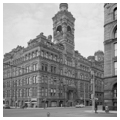When Wisconsin was the world’s leading wheat producer in the 1850s, Milwaukee bustled as a grain shipping and trade center. The Chamber of Commerce Building’s Grain Exchange Room, where commodities traders haggled over wheat prices, was the original trading pit, an octagonal, stepped depression. Stock and commodities exchanges throughout the country soon adopted this innovation. Restored in the 1980s, the huge Grain Exchange Room is a free expression of late Renaissance style and one of America’s finest examples of a late-1870s commercial interior. The original trading pit location is marked in the floor with a full-size plaque. Colorful frescoes of Wisconsin wildflowers on the ceiling and murals depicting steamships and locomotives steaming to and from Milwaukee during its wheat-shipping heyday were designed by P. M. Almini of Chicago.
The building is impressive not only for its place in history but also for its exterior design. Mix created a stunning five-and-a-half-story edifice with symmetrical facades, divided vertically into bays and horizontally by cornices of varying patterns, all topped with a mansard roof. The stocky clock tower houses a massive, 2,000-pound bronze bell in its open belfry. The variety of ornament—bold and delicate, angular and curvilinear, classical and abstract—is noteworthy for its almost playful creativity. Mix’s composition may have been inspired by the work of Philadelphia architect Frank Furness, then in the prime of his career.




















